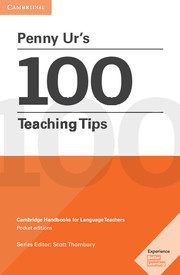Book contents
- Frontmatter
- Contents
- Why I Wrote this Book
- Beginning and Ending the Lesson
- The Coursebook
- Discipline
- Error Correction
- Games
- Grammar
- Group Work
- Heterogeneous (Mixed-Level) Classes
- Homework
- Interest
- Listening
- Pronunciation
- Reading Comprehension
- Speaking Activities
- Teacher Talk
- Testing and Assessment
- Vocabulary Teaching
- Writing
- P.S.
- Index
- Photo Acknowledgements
Why I Wrote this Book
Published online by Cambridge University Press: 17 November 2023
- Frontmatter
- Contents
- Why I Wrote this Book
- Beginning and Ending the Lesson
- The Coursebook
- Discipline
- Error Correction
- Games
- Grammar
- Group Work
- Heterogeneous (Mixed-Level) Classes
- Homework
- Interest
- Listening
- Pronunciation
- Reading Comprehension
- Speaking Activities
- Teacher Talk
- Testing and Assessment
- Vocabulary Teaching
- Writing
- P.S.
- Index
- Photo Acknowledgements
Summary
English teachers in the course of their teaching careers accumulate a wealth of practical know-how about classroom teaching. But few of them publish this knowledge – mainly because they simply don't have the time. (There are, of course, websites with teaching guidance of one kind or another, though many of these are not very practical, and it takes a lot of surfing to find good ones.) So an enormous number of experienced-based insights discovered by expert teachers in the course of their teaching careers are lost as far as future generations of teachers are concerned. The result is that many new teachers find themselves laboriously ‘re-inventing the wheel’, or discovering a useful teaching idea much too late, when they could have shortened the process by learning from their predecessors. (‘Why did nobody tell me…?!’)
So having myself retired from school teaching – though I still teach academic English to adults – it seemed a good idea to write my own set of practical tips, from which other teachers might benefit.
I started teaching English in a primary school in Israel in 1968. It was a fairly discouraging experience at first, with lots of discipline problems and misunderstandings, since I didn't know my students’ language very well, and wasn't familiar with the culture. I remember telling a colleague at the end of my first year that I didn't think I should continue because I was clearly not suited to English teaching. He told me to stop thinking so much about my own problems and look at my students: ask myself whether they were learning from my lessons, and whether they were motivated to continue learning. If they were, he said, I was a successful teacher and should continue. So I did, and I did. I suppose this is my first and perhaps most basic tip: don't worry so much about yourself and your teaching, look at the students, and what and how they are learning. Anyhow, I went on to teach English in primary and secondary classes in State schools – with some breaks to teach university courses or to study – until I retired in 2006. I must have clocked up thousands of hours of classroom teaching. My professional knowledge derives primarily from that experience, and is the basis of the tips in this book.
- Type
- Chapter
- Information
- Penny Ur's 100 Teaching TipsCambridge Handbooks for Language Teachers, pp. viiiPublisher: Cambridge University PressPrint publication year: 2016

